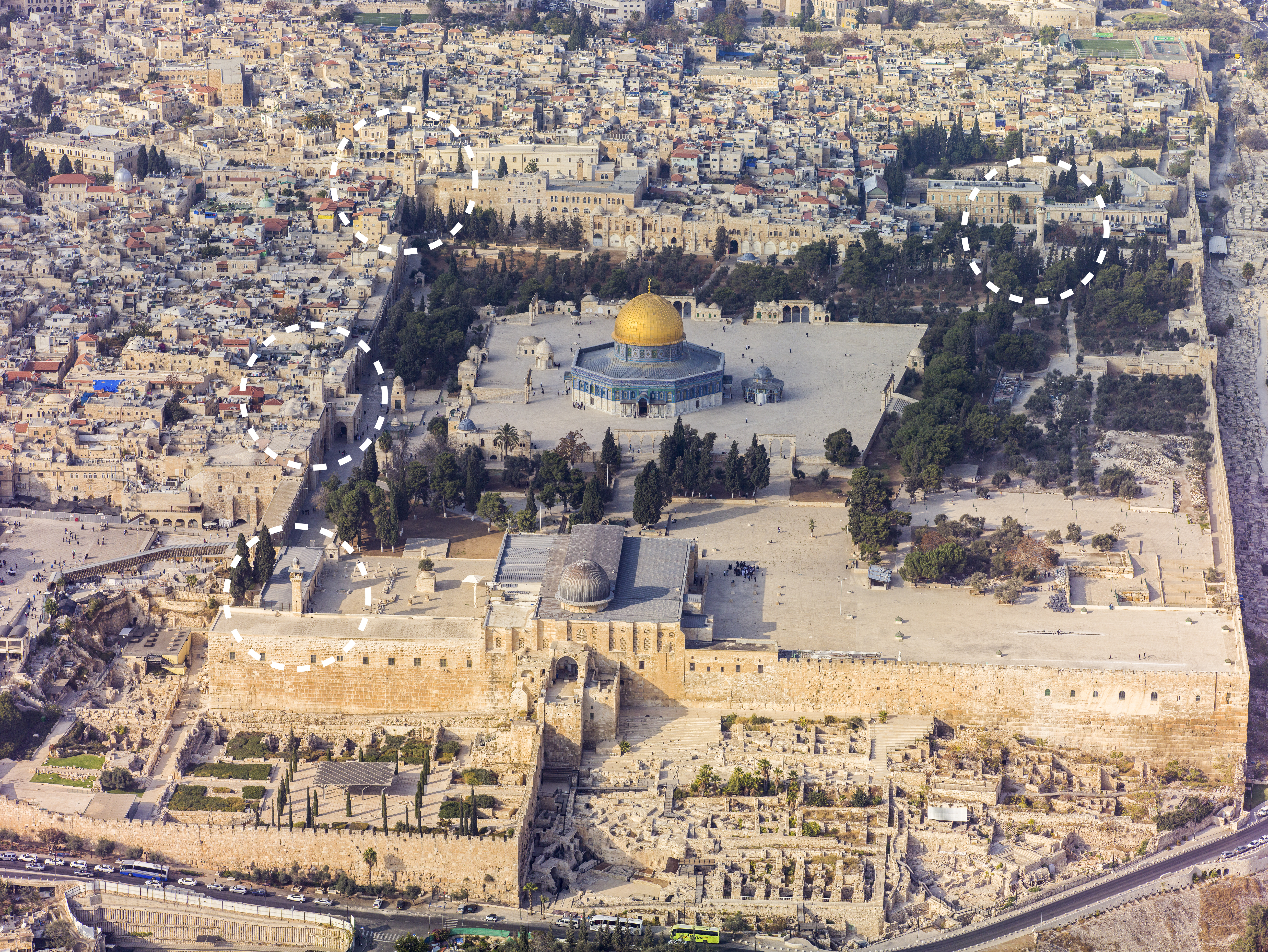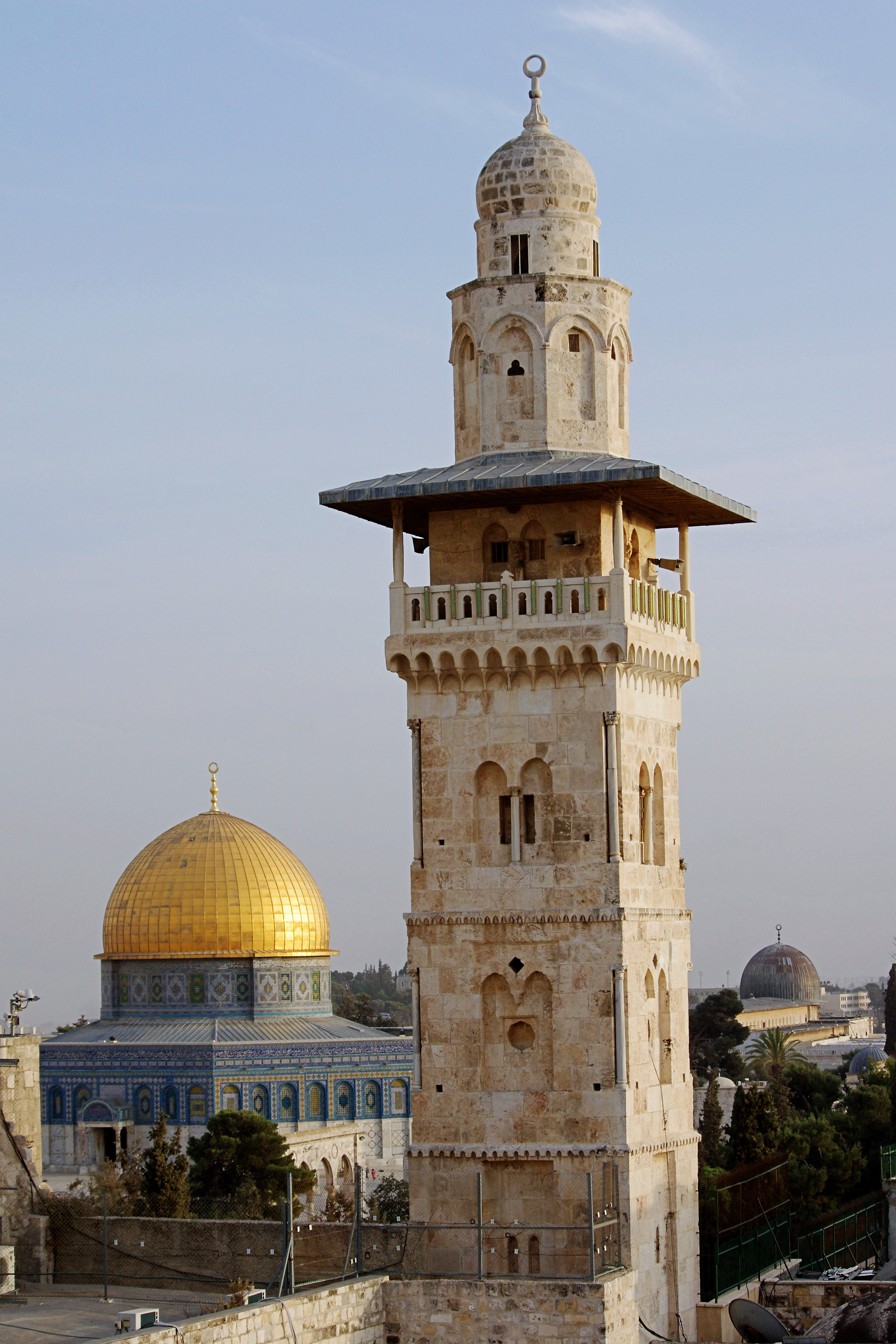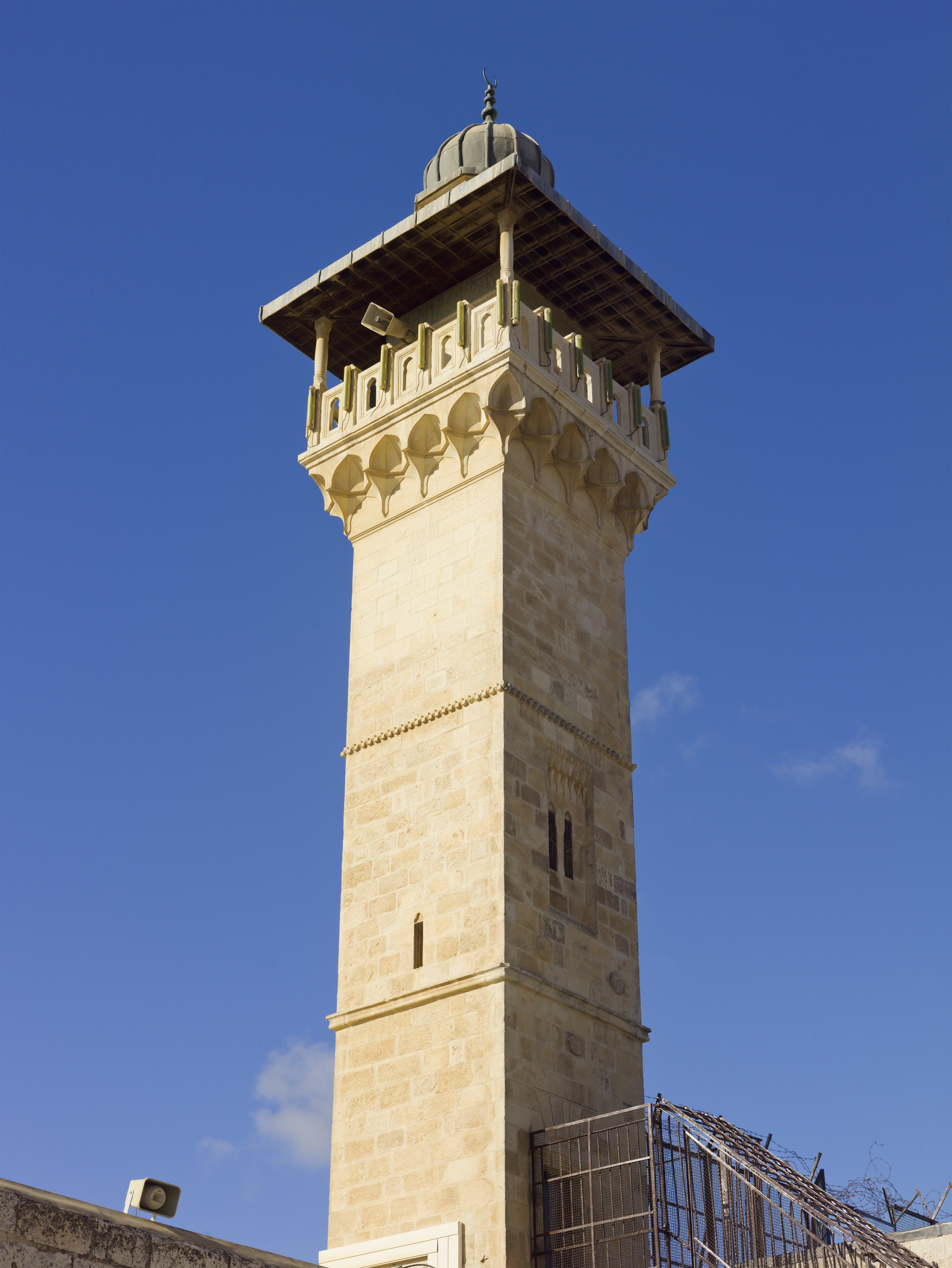Al-Fakhariyya Minaret on:
[Wikipedia]
[Google]
[Amazon]
 The
The
 The Ghawanima Minaret or Al-Ghawanima Minaret was built at the northwestern corner of the Noble Sanctuary during the reign of Sultan
The Ghawanima Minaret or Al-Ghawanima Minaret was built at the northwestern corner of the Noble Sanctuary during the reign of Sultan
 In 1329,
In 1329,
 The Fakhriyya Minaret or Al-Fakhiriyya Minaret, was built on the junction of the southern wall and western wall, over the solid part of the wall. The exact date of its original construction is not known but it was built sometime after 1345 and before 1496. It was named after Fakhr al-Din al-Khalili, the father of Sharif al-Din Abd al-Rahman who supervised the building's construction. The minaret was rebuilt in 1920.
The Fakhriyya Minaret was built in the traditional
The Fakhriyya Minaret or Al-Fakhiriyya Minaret, was built on the junction of the southern wall and western wall, over the solid part of the wall. The exact date of its original construction is not known but it was built sometime after 1345 and before 1496. It was named after Fakhr al-Din al-Khalili, the father of Sharif al-Din Abd al-Rahman who supervised the building's construction. The minaret was rebuilt in 1920.
The Fakhriyya Minaret was built in the traditional
 The last and most notable minaret was built in 1367: the Minaret, near the
The last and most notable minaret was built in 1367: the Minaret, near the
Archnet Digital Library.
 The
The Al-Aqsa
Aqsa'', ''Aksa, al-Aksa or al-Aqsa ( ar, الأقصى, link=no, translit=al-Aqṣā) usually refer to either:
*al-Aqsa Mosque compound, also known as , a religious site in Jerusalem located on the Temple Mount
*, also known as the Qibli Mosque, ...
mosque compound in the Old City of Jerusalem has four minaret
A minaret (; ar, منارة, translit=manāra, or ar, مِئْذَنة, translit=miʾḏana, links=no; tr, minare; fa, گلدسته, translit=goldaste) is a type of tower typically built into or adjacent to mosques. Minarets are generall ...
s in total: three on the western flank and one on the northern flank.
Background
Early Muslim writer Shihab Al-Din Ahmad Ibn Muhammad Ibn 'Abd Rabbihi (d. 940 AD), in his ''Kitab Al-Iqd Al-Farid'', describe the pre-Crusader Al-Aqsa enclave as having four minarets. After they conquered Jerusalem, defeating the Crusaders, theMamluks
Mamluk ( ar, مملوك, mamlūk (singular), , ''mamālīk'' (plural), translated as "one who is owned", meaning "slave", also transliterated as ''Mameluke'', ''mamluq'', ''mamluke'', ''mameluk'', ''mameluke'', ''mamaluke'', or ''marmeluke'') i ...
built or renovated eight major minarets in the Holy City. Dating of the minarets in Jerusalem has been done according to the style and shape. Mamluk minarets generally have a square shape and are built at various locations along the perimeter of the Haram al-Sharif.
The four minarets
Ghawanima Minaret
 The Ghawanima Minaret or Al-Ghawanima Minaret was built at the northwestern corner of the Noble Sanctuary during the reign of Sultan
The Ghawanima Minaret or Al-Ghawanima Minaret was built at the northwestern corner of the Noble Sanctuary during the reign of Sultan Lajin
Lachin ( ar, لاجين), full royal name al-Malik al-Mansour Hossam ad-Din Lachin al-Mansuri (; d. January 16, 1299, Cairo) was a Mamluk sultan of Egypt from 1296 to 1299. Originally Greek, he was a mamluk of Al-Mansur Qalawun and had participate ...
circa 1298, or between 1297 and 1299, or circa circa 1298. It is named after Shaykh Ghanim ibn Ali ibn Husayn, who was appointed the Shaykh of the Salahiyyah Madrasah by Saladin
Yusuf ibn Ayyub ibn Shadi () ( – 4 March 1193), commonly known by the epithet Saladin,, ; ku, سهلاحهدین, ; was the founder of the Ayyubid dynasty. Hailing from an ethnic Kurdish family, he was the first of both Egypt and ...
.
The minaret is located near the Ghawanima Gate and is the most decorated minaret of the compound. It is 38.5 meters tall, with six stories and an internal staircase of 120 steps, making it the highest minaret inside the Al-Aqsa compound. Its design may have been influenced by the Romanesque style of older Crusader buildings in the city.
The tower's main shaft is cuboid
In geometry, a cuboid is a hexahedron, a six-faced solid. Its faces are quadrilaterals. Cuboid means "like a cube", in the sense that by adjusting the length of the edges or the angles between edges and faces a cuboid can be transformed into a cub ...
, with a square base, while its upper part, above the balcony, is octagonal. It is almost entirely made of stone, apart from a timber canopy over the muezzin
The muezzin ( ar, مُؤَذِّن) is the person who proclaims the call to the daily prayer ( ṣalāt) five times a day (Fajr prayer, Zuhr prayer, Asr prayer, Maghrib prayer and Isha prayer) at a mosque. The muezzin plays an important role ...
's balcony. Marble columns are employed in its decoration. The minaret is excavated into the naturally occurring layer of bedrock in the northwest corner of the Haram. The main part of the tower has a cuboid shape with a square base. It is partitioned into several 'stories', visually divided on the outside by stone moldings and ''muqarnas
Muqarnas ( ar, مقرنص; fa, مقرنس), also known in Iranian architecture as Ahoopāy ( fa, آهوپای) and in Iberian architecture as Mocárabe, is a form of ornamented vaulting in Islamic architecture. It is the archetypal form of I ...
'' (stalactite) cornice
In architecture, a cornice (from the Italian ''cornice'' meaning "ledge") is generally any horizontal decorative moulding that crowns a building or furniture element—for example, the cornice over a door or window, around the top edge of a ...
s. The first two stories are wider and form the base of the tower, followed by an additional four stories, including the muezzin's gallery or balcony. Above the level of the balcony is a smaller octagonal turret surmounted by a bulbous dome with a circular drum. The stairway is external on the first two floors but becomes an internal spiral structure until it reaches the muezzin's gallery, from which the call for prayer was performed.
The western tunnel, which was dug by the Israeli state, has weakened the minaret's foundations, resulting in calls for its renovation in 2001. Also, the Islamic Waqf Directorate has renovated this gate after an Israeli extremist burnt it in 1998.
Bab al-Silsila Minaret (Minaret of the Chain Gate)
Tankiz
Sayf ad-Din Tankiz ibn Abdullah al-Husami an-Nasiri better known simply as Tankiz ( ar, تنكيز) (died May 1340) was the Damascus-based Turkic ''na'ib al-saltana'' (viceroy) of Syria from 1312 to 1340 during the reign of the Bahri Mamluk sulta ...
, the Mamluk governor of Syria, ordered the construction of a third minaret, known as the Bab al-Silsila Minaret (Minaret of the Chain Gate), near the Chain Gate
The Chain Gate ( ar, باب السلسلة, ) is one of the gates to the Al-Aqsa Mosque compund on the Temple Mount in the Old City of Jerusalem. It was previously known as David's Gate.
It was also known as ( Gate of the Law Court), named afte ...
, on the western border of the al-Aqsa Mosque. The minaret is also known as Mahkamah Minaret since the minaret is located near the Madrasa al-Tankiziyya which served as a law court during the times of Ottomans
The Ottoman Turks ( tr, Osmanlı Türkleri), were the Turkic founding and sociopolitically the most dominant ethnic group of the Ottoman Empire ( 1299/1302–1922).
Reliable information about the early history of Ottoman Turks remains scarce, ...
.
This minaret, possibly replacing an earlier Umayyad
The Umayyad Caliphate (661–750 CE; , ; ar, ٱلْخِلَافَة ٱلْأُمَوِيَّة, al-Khilāfah al-ʾUmawīyah) was the second of the four major caliphates established after the death of Muhammad. The caliphate was ruled by the ...
minaret, is built in the traditional Syrian square tower type and is made entirely out of stone.
Since the 16th century, it has been a tradition that the best muezzin of the ''adhan
Adhan ( ar, أَذَان ; also variously transliterated as athan, adhane (in French), azan/azaan (in South Asia), adzan (in Southeast Asia), and ezan (in Turkish), among other languages) is the Islamic call to public prayer (salah) in a mos ...
'' (the call to prayer) is assigned to this minaret because the first call to each of the five daily prayers is raised from it, giving the signal for the muezzins of mosques throughout Jerusalem to follow suit.
It is located next to the Chain Gate on the porches to the west of Masjid al-Aqsa. It is on a square-shaped platform with four corners and has a closed balcony, which is kept standing by stone columns. It has an internal staircase with 80 steps. The minaret is reached via the Madrasa al-Ashrafiyya. The height of the minaret is 35 meters. It was repaired by the Islamic Foundation after the Jerusalem earthquake in 1922.
Bab al-Silsila Minaret is bordered by Al Aqsa Compound
The Temple Mount ( hbo, הַר הַבַּיִת, translit=Har haBayīt, label=Hebrew, lit=Mount of the House f the Holy}), also known as al-Ḥaram al-Sharīf (Arabic: الحرم الشريف, lit. 'The Noble Sanctuary'), al-Aqsa Mosque compoun ...
's main entrance. As stated in the inscriptions, its reconstruction was done by the Governor of Syria when Amir Tankiz was establishing the Madrasa al-Tankiziyya. It was replaced by an Ottoman-style 'pencil point' spire, which was replaced by a smooth cutout and a semicircular dome after the dome was damaged in an earthquake in the 19th century. During the restoration of 1923-4, the existing canopy and lead coating on the dome were erected.
Today, Israeli security forces do not allow Muslims to approach or enter Bab al-Silsila Minaret, as they believe they protect praying Jews in front of the Western Wall
The Western Wall ( he, הַכּוֹתֶל הַמַּעֲרָבִי, HaKotel HaMa'aravi, the western wall, often shortened to the Kotel or Kosel), known in the West as the Wailing Wall, and in Islam as the Buraq Wall (Arabic: حَائِط � ...
which is near Bab al-Silsila Minaret.
Fakhriyya Minaret
 The Fakhriyya Minaret or Al-Fakhiriyya Minaret, was built on the junction of the southern wall and western wall, over the solid part of the wall. The exact date of its original construction is not known but it was built sometime after 1345 and before 1496. It was named after Fakhr al-Din al-Khalili, the father of Sharif al-Din Abd al-Rahman who supervised the building's construction. The minaret was rebuilt in 1920.
The Fakhriyya Minaret was built in the traditional
The Fakhriyya Minaret or Al-Fakhiriyya Minaret, was built on the junction of the southern wall and western wall, over the solid part of the wall. The exact date of its original construction is not known but it was built sometime after 1345 and before 1496. It was named after Fakhr al-Din al-Khalili, the father of Sharif al-Din Abd al-Rahman who supervised the building's construction. The minaret was rebuilt in 1920.
The Fakhriyya Minaret was built in the traditional Syria
Syria ( ar, سُورِيَا or سُورِيَة, translit=Sūriyā), officially the Syrian Arab Republic ( ar, الجمهورية العربية السورية, al-Jumhūrīyah al-ʻArabīyah as-Sūrīyah), is a Western Asian country loc ...
n style, with a square-shaped base and shaft, divided by moldings into three floors above which two lines of ''muqarnas'' decorate the muezzin's balcony. The niche is surrounded by a square chamber that ends in a lead-covered stone dome. After the minaret was damaged in the Jerusalem earthquake, the minaret's dome was covered with lead.
Bab al-Asbat Minaret (Minaret of the Tribes' Gate)
 The last and most notable minaret was built in 1367: the Minaret, near the
The last and most notable minaret was built in 1367: the Minaret, near the Tribes' Gate
The Temple Mount, located in Jerusalem, has twelve gates, one of which, Bab as-Sarai, is now closed to the public but was open during Ottoman rule. There are also six other sealed gates. This does not include the Gates of the Old City of Jerusa ...
( Gate). It is composed of a cylindrical stone shaft (built later by the Ottomans), which springs up from a rectangular Mamluk-built base on top of a triangular transition zone. The shaft narrows above the muezzin's balcony and is dotted with circular windows, ending with a bulbous
In botany, a bulb is structurally a short stem with fleshy leaves or leaf basesBell, A.D. 1997. ''Plant form: an illustrated guide to flowering plant morphology''. Oxford University Press, Oxford, U.K. that function as food storage organs durin ...
dome. The dome was reconstructed after the 1927 earthquake.Bab al-Asbat MinaretArchnet Digital Library.
Proposed fifth minaret
There are no minarets in the eastern portion of the mosque. However, in 2006,King Abdullah II of Jordan
Abdullah II bin Al-Hussein ( ar, عبدالله الثاني بن الحسين , translit=ʿAbd Allāh aṯ-ṯānī ibn al-Ḥusayn; born 30 January 1962) is King of Jordan, having ascended the throne on 7 February 1999. He is a member of t ...
announced his intention to build a fifth minaret overlooking the Mount of Olives
The Mount of Olives or Mount Olivet ( he, הַר הַזֵּיתִים, Har ha-Zeitim; ar, جبل الزيتون, Jabal az-Zaytūn; both lit. 'Mount of Olives'; in Arabic also , , 'the Mountain') is a mountain ridge east of and adjacent to Jeru ...
. The King Hussein Minaret is planned to be the tallest structure in the Old City Old City often refers to old town, the historic or original core of a city or town.
Old City may refer to several places:
Historical cities or regions of cities
''(by country)''
*Old City (Baku), Azerbaijan
* Old City (Dhaka), Bangladesh, also ca ...
of Jerusalem
Jerusalem (; he, יְרוּשָׁלַיִם ; ar, القُدس ) (combining the Biblical and common usage Arabic names); grc, Ἱερουσαλήμ/Ἰεροσόλυμα, Hierousalḗm/Hierosóluma; hy, Երուսաղեմ, Erusałēm. i ...
.
References
External links
* https://archnet.org/sites/3064 * https://www.tandfonline.com/doi/abs/10.1179/peq.1887.19.2.90 * https://www.islamiclandmarks.com/ {{DEFAULTSORT:Minarets Of The Temple Mount Al-Aqsa Minarets Mamluk architecture in the State of Palestine